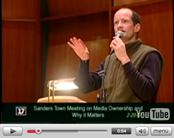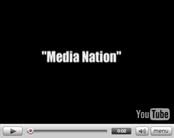Discuss E-List
Essential Resources Guide
FREE Teaching Resources
Membership Benefits
Partner Discounts
Summit 2006
Hollywood's new "media literacy" curriculum
There is a new media literacy curriculum. It is at:
http://www.oscars.org/education-outreach/teachersguide/medialiteracy/pdf...
This curriculum, produced by Hollywood's premier representative, the MPAA, is a joke. It is what John Stauber calls astroturf public relations. It is media literacy very, very lite.
Guess what? It avoids tobacco or any other health-related negative modeling by Hollywood movies. Last year, TWO-THIRDS of the billions of tobacco impressions that top movies delivered to theater audiences were rated PG-13 (current article from ACME partner Stan Glantz below).
It is clearly an attempt to deflect growing public awareness and criticism led by well financed and researched critics, just one of which is the anti-tobacco folks, who KNOW that the number one cause of smoking initiation is movies, particularly PG-13 movies.
Since the master tobacco settlement agreement, smoking in youth rated movies has skyrocketed.
Big Tobacco tried "educational programs, and Phillip Morris still secretly supports the biggest (with its weak mediaed component). Big Oil did the same thing (Exxon and Shell's "environmental" awareness curricula) as did Channel One with its most widely disseminated medialit program ever (written by Renee H. -- more well financed media literacy lite).
Today we have Big Coal (60 minutes the week before last) expounding "Clean coal!" What a winner that PR oxymoron is!
This curriculum allows Big Movies to say they are being responsible, like booze companies saying, "please drink responsibly" when they know that the alcoholics drink the biggest percentage of the booze and give them their greatest profits.
Question: What does it say when last year EVERY non-animated Academy Award nominated movie included smoking? And these are, the "good" movies. The real money is in cranking out those low budget sex, drugs, rock'n roll, slasher and smasher movies with their grinning glorification of an ever coarser culture and an ever simpler way of solving problems.
Actually, it would be nice if this "curriculum" addressed product placement, drugs, corporate malfeasance, government corruption and/or a hedonstic, anti-intellectual culture of which Hollywood is the biggest promoter
Here is a typical example of media literacy lite in this curriculum. They mention the movie Network and suggest discussing it, but give no sharp, leading questions to point the discussion toward the main themes of the movie--trivialization by media monopolies!
Like all media literacy lite curricula, they are predominantly interested in getting kids to think about camera angles, costumes and beauty of fast action-movie car chases.
I'm not kidding. "The editing sets a breathless pace, cutting quickly between the racers, their souped-up gear, flashing warning lights, and the train.." Now, that's just great -- a mediaed curriculum extolling the wonder of car chases!
You will love this: when discussing Erin Brockovich, it is ALL about the tone of her language, NOTHING about corporate rape of the environment, coverups or the value of plaintiff's lawyers.
That paragraph is an insult to Erin, a great movie and women everywhere.
So goes this astroturf curriculum,
Sigh,
Bob McCannon
Media Educator of the Year -- American Academy of Pediatrics, Boston, October, 2008
Co-President: The Action Coalition for Media Education, www.acmecoalition.org
Author, "Media Literacy/Media Education Review" Children Adolescents and Media, 2nd edition, college text, 2008
Presenter, Media Educator, Consultant, mccannon@flash.net (505) 839-9702
Executive Director, 1993 -2005, NM Media Literacy Project (founded 1993)
See the actual ad at http://www.smokefreemovies.ucsf.edu/ourads/ad_sfm61_variety.htm
Last year, two-thirds of the billions of tobacco impressions that top movies delivered to theater audiences were rated PG-13.
Twelve billion tobacco impressions rated PG-13. In 2007, the major studios’ trade group, the MPAA, announced it was going to “consider” smoking in ratings. Today, the PG-13 films that adolescents see most often have become the biggest part of the smoking problem.
Parents still have no reliable advance warning. Because the film industry fails to put even a smoking label on most wide-release, kid-rated films with tobacco — let alone the R-rating the public wants.
What are major studios doing instead? Last week, their lobbyists were ripping a loophole in a landmark North Carolina smokefree workplace bill, just to protect tobacco smoking in film productions.
Even with their much larger film sectors, California and New York don’t give film productions a free pass on secondhand tobacco smoke. But apparently, the major studios wanted a law that would.
On-screen smoking will cause 120,000 tobacco deaths a year. Why isn’t the film industry doing a better job protecting young people? The answer is obvious. It’s still too busy pushing tobacco.
Smoke Free Movies
See smoking trends at major studios and independents, online.
SmokeFreeMovies.ucsf.edu
Smoking in movies kills in real life. | Smoke Free Movie policies—the R-rating, certification of no payoffs, anti-tobacco spots, and an end to brand display—are endorsed by the World Health Organization, American Medical Association, AMA Alliance, American Academy of Pediatrics, American Heart Association, American Legacy Foundation, American Lung Association, Americans for Nonsmokers’ Rights, American Public Health Association, Campaign for Tobacco-Free Kids, L.A. County Dept. of Health Services, New York State Dept. of Health, New York State PTA, and many others. Visit our web site or write: Smoke Free Movies, UCSF School of Medicine, San Francisco, CA 94143-1390.
Also, check out the new one page “Solutions” and “Timeline” handouts near the bottom of http://www.smokefreemovies.ucsf.edu/actnow/organizing_tools.html



![View your cart items []](/sites/default/modules/ecommerce/cart/images/cart_empty.png)





